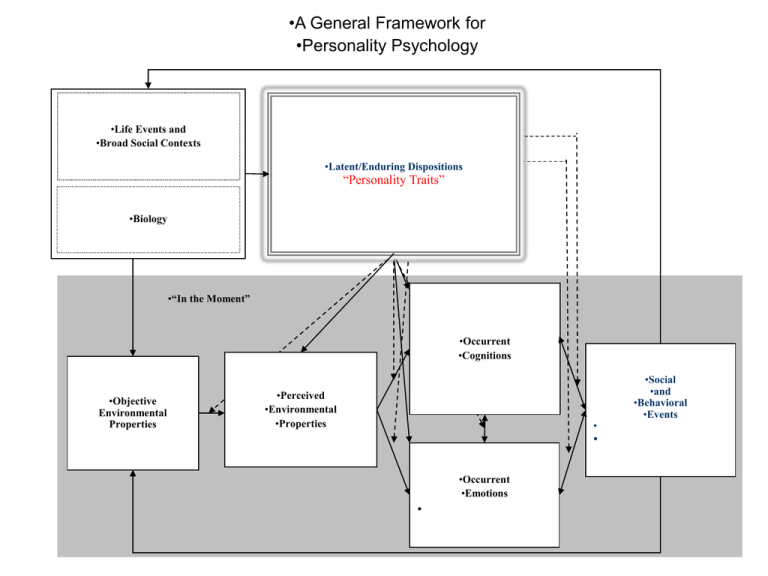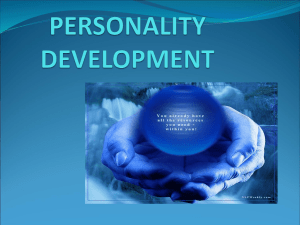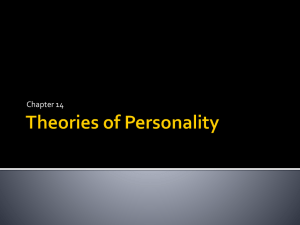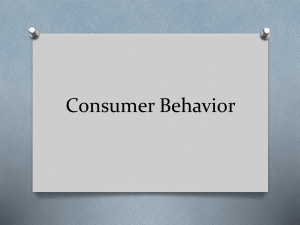
•A General Framework for
•Personality Psychology
•Life Events and
•Broad Social Contexts
•Latent/Enduring Dispositions
“Personality Traits”
•Biology
•“In the Moment”
•Occurrent
•Cognitions
•Objective
Environmental
Properties
•Perceived
•Environmental
•Properties
•
•
•Occurrent
•Emotions
•
•Social
•and
•Behavioral
•Events
Trait Approach to Personality
Trait Approach – Goals
Know definition of “trait”
Recognize potential problems with trait concept
Understand how traits are “used” in personality
psychology
Know the fundamental “broad” traits and understand
the scientific process through which they have
been identified
Evaluate whether traits are, in fact, related to
important events, outcomes, etc.
What is a “Personality Trait”?
A relatively stable tendency to think, feel, and
act in certain ways.
Issues with the “trait” concept
• Traits vs “types”?
• Causal entities or Summary labels? (circular?)
• Individual Differences in general tendencies
(what about variability?)
• Behavioral prediction and behavioral consistency?
Are “Traits” Useful, Valid Scientific
Concepts?
Walter Mischel (1968) “Person-situation Debate”:
1) “Global traits” do not predict behavior within
specific situations very well. (r < .30)
2) Individual differences in behavior are not consistent
across specific situations
Implications for “trait” as useful for understanding
behavior?
So, are “Traits” useful concepts?
Person-situation debate - implications
– During the Nuremberg trials after World War
II, some participants in wartime atrocities
defended themselves by saying they were “only
following orders.” Is this the same thing as
saying that the situation was so strong that their
behavior was not determined by their own
personal characteristics, so they should not be
blamed? What do you think of this defense?
Person-situation debate - implications
Sociologists point out that criminal behavior is much
more likely from people who come from crimeprone neighborhoods, low economic levels, and
unstable family backgrounds. These are all
situational factors. Does this fact imply that crime
comes from the situation and not from the person?
If so, how can we hold a person responsible for
criminal actions?
Trait Approach – Goals
Know definition of “trait”
Recognize potential problems with trait concept
Understand how traits are “used” in personality
psychology
Know the fundamental “broad” traits and understand
the scientific process through which they have
been identified
Evaluate whether traits are, in fact, related to
important events, outcomes, etc.
How are “traits” used Personality
Psychology?
Some uses of “traits”:
• Understand an individual
• Understand a group (prototypical group member)
• Understand the personality implications of an important
psychological quality or behavior
• Predict behavior, feelings
• Predict important events in life (death)
Using Traits to Understand an Individual:
MMPI Profile an 18-yr old Male college student
100.0
90.0
T Score
80.0
70.0
60.0
50.0
40.0
30.0
L
F
K
Hs
D
Hy
Pd
Mf
Pa
Pt
Basic Validity and Clinical Scales
18-yr old male college student, referred for treatment after being
arrested for making harassing phone calls to a young woman he had
known for years
Sc
Ma
Si
MMPI Scales
Hypochondriasis (Hs) - neurotic concern over bodily functioning.
Depression (D) - poor morale, lack of hope in the future, and a general dissatisfaction
with one's own life situation.
Hysteria (Hy) - This scale was developed to identify patients who demonstrated
hysterical reactions to stress situations. When under stress, they develop conversiontype symptoms as a means of resolving conflict and avoiding responsibility
Psychopathic Deviate (Pd) - This scale was originally developed to identify patients
diagnosed as psychopathic personality, asocial or amoral type.
Masculinity-Femininity (Mf) - Scale 5 was originally developed by Hathaway and
McKinley to identify homosexual invert males. Scores that are markedly higher than
expected for males, based on the persons' intelligence, education, and social class
should suggest the possibility of sexual concerns and problems.
MMPI Scales
Paranoia (Pa) - feelings of persecution, grandiose self-concepts, suspiciousness,
excessive sensitivity, and rigid opinions and attitudes.
Psychasthenia (Pt) anxiety, obsessive-compulsive disorder, abnormal fears, selfcriticism, difficulties in concentration, and guilt feelings. .
Schizophrenia (Sc) - bizarre thought processes and peculiar perceptions, social
alienation, poor familial relationships, difficulties in concentration and impulse
control, lack of deep interests, disturbing questions of self-worth and self-identity,
and sexual difficulties.
Hypomania (Ma) - Elevated mood, accelerated speech and motor activity,
irritability, flight of ideas, and brief periods of depression.
Social Introversion (Si) - insecure and uncomfortable in social situations. They
tend to be shy, reserved, timid, and retiring, while low scorers tend to be outgoing,
gregarious, friendly, and talkative.
Using Traits to Understand an Individual
Duckworth, J. C., & Anderson, W. P. (1995).
Clinical Interpretation
MMPI Profile an 18-yr old Male college student
100.0
This configuration indicates an angry,
hostile, antisocial individual who is
overall sensitive to perceived insults.
It is unlikely that he will have any deep
social relationships This will be partly
the result of his suspiciousness and
distrust of others, but also reflects the
fact that he is likely to be unfriendly to
others and to have unusual thoughts
that when shared with others cause
them to back away from him. Other
people who know him are likely to
report that they seem him as creepy
90.0
T Score
80.0
70.0
60.0
50.0
40.0
30.0
L
F
K
Hs
D
Hy
Pd
Mf
Pa
Basic Validity and Clinical Scales
Pt
Sc
Ma
Si
There is the potential for aggressive
acting out. The therapist should listen
carefully for any indications that action
is planned against the client's victim.
Using Traits to Understand Groups
Cumella, E. J., Wall, A. D., & Kerr-Almeida, N. (2000).
MMPI Profiles - Inpatient Assessments of
Women With Eating Disorders
100.0
90.0
T Score
80.0
70.0
60.0
50.0
40.0
30.0
L
F
K
Hs
D
Hy
Pd
Mf
Pa
Pt
Sc
Ma
Basic Validity and Clinical Scales
An Nerve - Rest
An Nerv - B/P
Bulimia
Eat Dis, NOS
Si
Using Traits to Understand a
Psychological Quality or Behavior
How is non-clinical depression (NCD)
related to self-perceptions, interpersonal
behavior, and social reputation?
--Creation of one’s social world-NCD
Social
Behavior
Partner’s
Behavior
Partner’s
perception
of “target”
person
Using Traits to Understand a
Psychological Quality or Behavior
(Furr & Funder, 1998)
Example: Depressive emotions
How do people who tend to experience depressive
symptoms see themselves?
140 Participants completed two measures (S data):
Depression Inventory
California Q-set (100 personality trait items)
Look at correlations between Dep score and EACH
CQ item.
Using Traits to Understand a
Psychological Quality or Behavior
How do students with relatively high levels of non-clinical depression (NCD) see themselves?
CAQ Item
Correlation
Feels a lack of personal meaning in life .53
Feels cheated and victimized by life
.52
Concerned with adequacy as a person .43
Ego-brittle – disorganized under stress .36
Is basically anxious .
.34
Is self-defeating
.30
Tends to ruminate
.29
Interprets simple events as complicated .29
Tends to be self-defensive
.29
Tends to undermine, obstruct, sabotage .29
CAQ Item
Correlation
Feels satisfied with self
High aspiration level for self
Is cheerful
Physically attractive
Regards self as physically attractive
Has a high degree of intellect
Is verbally fluent; express ideas well
Internally consistent personality
Is straightforward, forthright, candid
How do students with high levels of NCD act with opposite sex strangers?
(Behavioral Prediction)
-.52
-.45
-.42
-.36
-.34
-.33
-.31
-.31
-.31
Using Traits to Understand a
Psychological Quality or Behavior
Behavioral Correlates of NCD – Females
Correlations Between Female’s Depression Scores and their behavior
Behavior
Correlation
Expresses insecurity
Self pity or feelings of victimization
Acts irritated
Gives up when faced with obstacles
Expresses criticism
Behaves in a fearful or timid manner
Expresses guilt. (About anything)
Says negative things about self
Compares self to others)
Blames others (For anything)
Shows signs of tension or anxiety
.38
.35
.31
.31
.30
.29
.27
.27
.26
.24
.24
Behavior
Correlation
Speaks fluently & expresses ideas well
Appears to be relaxed & comfortable
Exhibits social skills
Engages in constant eye contact
How do strangers react to students with high levels of NCD?
-.43
-.35
-.29
-.23
Using Traits to Understand a
Psychological Quality or Behavior
How do strangers react to students with relatively high levels of NCD?
Correlations Between Female’s Depression Scores and Male Stranger’s behavior
Male’s Behavior
Correlation
Acts stereotypically male
Talks at rather than with female
Exhibits condescending behavior
Acts irritated
Tries to control the interaction
Dominates the interaction
Seems detached
.35
.31
.30
.28
.27
.25
.20
Male’s Behavior
Correlation
Behaves cheerfully
Seems to like the female
Initiates humor
Interested in partner says
Acts playful
Laughs frequently
Enjoys the interaction
-.29
-.28
-.25
-.23
-.20
-.20
-.20
NEXT: How are students with relatively high levels of NCD seen by their close
acquaintances? Creation of long-term social environment
Using Traits to Understand….
Correlations between self-reported Dep score and Informant-reported CAQ items.
CQ Item
Correlation CQ Item
Feels a lack of personal meaning in life
Feels cheated and victimized by life
Is self-defeating
Has hostility towards others
Generally fearful
Distrustful of people in general
Tends to delay or avoid action
Is critical, skeptical, not easily impressed
Gives up in the face of frustration
Tends to transfer or project blame
Tends to undermine and obstruct
Keeps people at a distance;
Has fluctuating moods
Tends to be self-defensive
Is basically anxious
Is unpredictable and changeable
Over-reactive to minor frustrations
Is guileful and deceitful; manipulative,
.38
.38
.35
.34
.33
.31
.29
.27
.27
.25
.24
.24
.21
.21
.20
.20
.20
.18
Correlation
Is cheerful
Has high aspiration level for self
Feels satisfied with self
Dependable and responsible
Is skilled in social techniques
Responds to humor
Has social poise and presence
Gregarious
Is protective of those close to him or her
Is productive, gets things done
Is an interesting, arresting person
Has a wide range of interests
Has warmth; and compassion
Has insight into motives & behavior
Is turned to for advice and reassurance
Is verbally fluent; can express ideas well
Regards self as physically attractive
Straightforward, forthright, candid
-.40
-.33
-.31
-.30
-.29
-.26
-.26
-.24
-.23
-.21
-.20
-.20
-.20
-.19
-.18
-.18
-.18
-.17
Using Traits to Understand a
Psychological Quality or Behavior
How is non-clinical depression (NCD)
related to self-perceptions, interpersonal
behavior, and social reputation?
--Creation of one’s social world-NCD
Social
Behavior
Partner’s
Behavior
Partner’s
perception
of “target”
person
Trait Approach – Goals
Know definition of “trait”
Recognize potential problems with trait concept
Understand how traits are “used” in personality
psychology
Know the fundamental “broad” traits and understand
the scientific process through which they have
been identified
Evaluate whether traits are, in fact, related to
important events, outcomes, etc.
What are the Most Fundamental Traits?
How many traits are there?
How could we answer this question?
One idea - look to language to understand personality. Why?
Lexical Hypothesis
Gordon Allport: Allport & Odbert (1936) - 17, 953 individual
difference words
Can these be “boiled” down to the most essential few – what are
they and how could we even do this?
Ray Cattell – Factor Analysis
What are the Most Fundamental Traits?
How many “core” traits are there?
Assertive
Talkative
Dominant
Influential
Creative
Imaginative
Thoughtful
Intellectual
What are the Important Traits?
Cattell – Factor Analysis
A five-step, crash-course in Factor Analysis:
1) Ask people to rate themselves on each
term (How X are you on a 1 to 10 scale)?
2) Compute correlations among the terms. –
Do people who score high on one attribute
score high on the other?
What are the Important Traits?
Cattell – Factor Analysis
Correlation Matrix
Ass
Ass
Tlk Dom
Inf
Cre
Ima
Tho
Int
1.00
Tlk
.60 1.00
Dom
.59
.78 1.00
Inf
.47
.56
.46 1.00
Cre
.00
.00
.00
.00 1.00
Ima
.00
.00
.00
.00
.56 1.00
Tho
.00
.00
.00
.00
.67
.39 1.00
Int
.00
.00
.00
.00
.78
.45
.69 1.00
What are the Important Traits?
Cattell – Factor Analysis
Step 3) Interpret the pattern of correlations –
what is related to what? Are there clusters of
items? If so, why? “Factors”
Step 4) Psychologize – name the factors –
what are the underlying dimensions
What are the Important Traits?
Cattell – (some of) the 16 Factors
Factor
Description
Affectia
Intelligence
Ego strength
Dominance
Surgency
Super-ego strength
Parmia
Permsia
Coasthenia
Social-role concern
Protension
Autia
Outgoing – reserved
More – less intelligent
Emotionally stable – volatile
Assertive – humble
Happy-go-lucky – somber
Conscientious – impulsive
Adventurous – timid
Tender-minded – tough-minded
Individualistic – group-oriented
Socially mature – socially immature
Suspicious – trusting
Imaginative – Practical
What are the Important Traits?
The Five Factors of Personality
Extraversion
Neuroticism
Agreeableness
Conscientiousness
Openness to
Experience
What are the Important Traits?
The Five Factors of Personality
Factor
Description
Extraversion
Energetic, sociable vs shy,
reserved, introverted
High-strung, emotional vs
calm, emotionally stable
Imaginative, open-minded
vs traditional thinking
Friendly, trusting vs cold,
unkind
Dependable, organized vs
impulsive, careless
Neuroticism
Openness
Agreeableness
Conscientiousness
What are the Important Traits?
The Five Factors of Personality
-Plus a 6th?Factor
Description
Honesty/Humility
Genuine, Fair, Not Greedy,
Modest
“HEXACO” Model – Expansion of Big Five, by 1
•Honesty/Humility
•Emotional Stability
•eXtraversion
•Agreeableness
•Conscientiousness
•Openness
What are the Important Traits?
The Five Factors of Personality
Are the Big Five universal?
– Where to look?
• Different cultures, language systems
• Different species (Primates, Canines)
– What to look for?
• Factor structure
• Accuracy of trait judgments
What are the Important Traits?
The Five Factors of Personality
Big 5 as:
– “Primary Colors”
– Longitude and Latitude
– Hierarchy
What are the Important Traits?
The Five Factors of Personality
The Extraversion hierarchy
EXTRAVERSION
Ascendance
Dominance
Exhibition
Pos. Emotions
Joy
Enthusi
asm
Energy
Lively
Active
Venturesome
Exct
Seekng
Pref
Change
How are “traits” used Personality
Psychology?
Some uses of “traits”:
• Understand an individual
• Understand a group (prototypical group member)
• Understand the personality implications of an important
psychological quality or behavior
• Predict behavior, feelings
• Understand & Predict important events in life (death)
Can we use trait info to predict
important life outcomes?
Work
Love
Health
How might personality (ones own or someone
else’s?) be related to these?
Discuss
Personality and Career/Business
“Person-environment fit”
Do people with particular personality traits “fit” in
particular social environments? (selection) –
promote well-being, competence, satisfaction, etc
Job performance
Does personality predict job performance?
Personality, Leadership, and Ethical Behavior
Does a leader’s personality affect his/her
employee’s ethical behavior?
“Person-environment fit”
Do people with particular personality traits
“fit” in particular social environments?
(selection) – promote well-being, competence,
satisfaction, etc
Choice of work/career env
How should we think about types of careers?
Are traits related to career preferences?
Six Job Types (John Holland)
1. Realistic
–
–
Work with hands, tools, outdoors.
Agriculture, Police Officer, Construction
2. Investigative
–
–
Work on their own, observing, and solving
problems
Science, Engineering
Are traits related to career preferences?
Job Types (cont.)
3. Artistic
– Work with their minds—innovating, imagining,
and creating
– Art, Advertising, Architecture
4. Social
– Work with people--informing, helping, training
– Healing professions, Psychologist (counseling),
recreation & tourism
Are traits related to career preferences?
Job Types (cont.)
5. Enterprising
– Work with people--influencing, leading, or
managing
– Management, sales, HR
6. Conventional
– Work with words & numbers, carry out detailed
instructions
– Accounting, Finance, Banking
Are traits related to career preferences?
Do some kinds of people prefer certain kinds of
careers?
De Fruyt & Mervielde (1997).The five-factor model of personality and Holland’s RIASEC interest
types. Personality and Individual Differences,23, 87-103
934 students, many majors, mean age = 23.4
Completed measure of Big 5 & measure of “career
interests” (6 dimensions of career interests)
Predictions - Which traits would be associated with
which type of career interest? Discuss
Are traits related to career preferences?
Corrs between Big 5 and career interests:
Type of
Career
N
E
O
Realistic
-.06
-.03
-.03
Investigative -.04
.00
.25
Artistic
.04
.19
.55
Social
-.08
.38
.28
Enterprising
-.26
.51
.04
Conventional -.12
.08
-.22
A
-.04
.01
.05
.23
-.10
-.04
C
.00
.04
-.07
.06
.26
.31
Personality and Career/Business
“Person-environment fit”
Do people with particular personality traits “fit” in
particular social environments? (selection) –
promote well-being, competence, satisfaction, etc
Job performance
Does personality predict job performance?
Personality, Leadership, and Ethical Behavior
Does a leader’s personality affect his/her
employee’s ethical behavior?
Job performance
Does personality predict job performance?
Which traits (of the Big Five) would be most
strongly related to job performance and why?
Discuss
Personality and
Job
performance
Personality and Career/Business
“Person-environment fit”
Do people with particular personality traits “fit” in
particular social environments? (selection) –
promote well-being, competence, satisfaction, etc
Personality, Leadership, and Ethical Behavior
Does a leader’s personality affect his/her
employee’s ethical behavior?
Personality, Leadership, & Ethical Behavior
Example – Enron financial scandal and
collapse:
• Enron bankrupt and execs arrested,
• Arthur Anderson (largest accting firm in
world) dissolved
• Employees & shareholders lost billions in
retirement investments
.
Personality, Leadership, & Ethical Behavior
From the Markkula Center for Applied Ethics
What Really Went Wrong With Enron? A Culture of Evil?
What went wrong at Enron? In ethics, explanations tend to fall into three categories:
personal, organizational, and systemic.
Personal explanations look for the causes of evil in the character of the individuals who
were involved. Did this happen, for example, because the people involved were
vicious? Were they greedy? Were they stupid? Were they callous? Were they
intemperate? Were they lacking in compassion?
Organizational explanations look for causes in group influences. They take seriously the
ways that we influence each other when we do things as a group. These influences
include the shared beliefs that groups develop about who is important, what is
permissible, and how things are done here in this group. These include also the shared
values that we call a group culture, the rules or policies groups develop to govern their
interactions with each other and the rest of the world.
Systemic explanations look for causes outside the group, for example in the environmental
forces that drive or direct groups or individuals to do one thing rather than another.
These include laws and the regulations …., the economic and social institutions…. Etc,
Personality, Leadership, & Ethical Behavior
Walumbwa & Schaubroeck (2009). Leader Personality Traits and Employee Voice Behavior: Mediating Roles of Ethical
Leadership and Work Group Psychological Safety. Journal of Applied Psychology, 94, 1275–1286.
Does a leader’s personality affect his/her employee’s
ethical behavior? Can a leader create a culture that
facilitates ethical behavior?
“ethical leaders not only inform individuals of the
benefits of ethical behavior and the cost of
inappropriate behavior; such leaders also set clear
standards and use rewards and fair and balanced
punishment to hold followers accountable for their
ethical conduct.”
Personality, Leadership, & Ethical Behavior
Walumbwa & Schaubroeck (2009). Leader Personality Traits and Employee Voice Behavior: Mediating Roles of Ethical
Leadership and Work Group Psychological Safety. Journal of Applied Psychology, 94, 1275–1286.
•Data from 222 supervisors, 894 employees from
financial firm
Personality, Leadership, & Ethical Behavior
.43*
.39*
.46*
.49*
-.12
So, leaders who are agreeable and/or conscientiousness tend to
exhibit ethical leadership, which seems to promote employees’
perceptions that they can express criticism/concerns, which
seems to promote their willingness to actually do so.
Personality, Leadership, & Ethical Behavior
How can we understand ethical behavior in the
business world?
Traits Personal explanations
Traits Organizational explanations (leaders’
personalities can affect organizational culture,
which affects employees’ ethical behavior
Systemic explanations (not psychological)
Personality and Relationship Functioning
Do some kinds of people have a tendency to be
more satisfied in relationships than other people?
Bouchard, Lussier, & Sabourin (1999). Personality and marital adjustment:” Utility of the fivefactor model of personality. Journal of Marriage and the Family, 61, 651-660
446 couples, avg age = mid 30’s, avg time living together = 9
years. Completed measure of Big 5, and measure of relationship
satisfaction
Corrs between Big 5 and marital satisfaction.
Predictions? Discuss
N
E
O
A
C
Males
-.24*
.15*
.10*
.23*
.24*
Females -.40*
.21*
.02
.25*
.17*
Are traits related to romantic satisfaction?
Do some kinds of people make their partner more satisfied?
Botwin, Buss, & Shackleford Journal of Personality
107 couples, Completed measure of Big 5, and measure of
relationship satisfaction.
Corrs between subject’s marital satisfaction and partner’s
personality traits:
Partner’s personality
Subject
N
E
O
A
C
Husband
-.27*
.12
.29*
.32*
.06
Wife
-.23*
.07
.31*
.37*
.20*
Interpretations?
What are the implications for the link
between personality and rel functioning?
Stability correlations:
Corr of Relationship scores at age 21 with Rel
scores at 26
Participants
Participants
Aspect
with Same
With Diff
of Rel
Partner
Partner
Quality
.40*
.24*
Conflict
.37*
.29*
Abuse
.44*
.29*
Implications?
Personality and Physical Health
In what ways could a person’s personality be
associated with whether he or she reports
having health problems?
How could “who you are” be related to your
physical health?
“Health Behavior Model”
Personality
Events that
might cause
stress
Interpret
events as
threatening
Health
Behaviors
Illness
Coping
response
Physiological
Arousal
From Weibe, D. J. & Smith, T. W. (1997). Personality and health: Progress and
problems in psychosomatics. In Handbook of Personality Psychology
Personality and Health –
Personality and Diabetes treatment
Are renal-failure patients’ personality traits
associated with time-of-health (ie, lack of
deterioration)?
Predictions (why?):
• C - positively correlated with time-of-health
(linear association)
• N - Medium N good (long time of health), Low
or high N bad (short time of health) (nonlinear
association)
Personality and Health –
Personality and Diabetes treatment
Study
– 85 patients with end-stage renal disease
– Completed a measure of the big 5 (NEO-PI-R)
– DV = renal deterioration time – rapidity of
deterioration (in years)
Personality and Health –
Personality and Diabetes treatment
Results supported predictions
•
•
•
•
Low risk group (High C and Med N)
High risk Group (Low C and high or low N)
Med risk Group (High C and high or low N)
Med risk Group (Low/Med C and med N)
Personality and Health –
Personality and Doctor/Patient
Communication
Association between Mother’s personality and
prospects for child’s health.
– Is mothers’ personality related to the quality of her
interaction with pediatrician?
– Are mothers’ personality traits related to her
behavior with doctor?
– Are mothers’ traits related to doctor’s behavior?
Personality and Health –
Personality and Doctor/Patient Comm.
Study
– 78 Mothers & children (< 2 yrs old)
– Mothers completed measure of Big 5
– Researchers recorded conversations between mother
and pediatrician:
– These were then coded into 10-15 communicative
behaviors (eg, giving medical information, or asking
for medical information, express humor & laughter,
expressive concerns, total length of conversation, etc)
Personality and Health –
Personality and Doctor/Patient Comm.
Results showed that mothers’ traits were indeed
related to her comm. beh with pediatrician
– Mothers high on E & C (and low on N) spoke more
to baby
– Mothers high on O
•
•
•
•
Asked for reassurance about child’s health
gave more medically relevant info to dr
Expressed humor & laughter
had longer conversations
Personality and Health –
Personality and Doctor/Patient Comunication
Results also showed that mother’s traits were
related to the pediatrician’s behavior
– In response to Mothers with high O, pediatricians
• Engaged in more conversation
• Expressed more humor and laughter
• Offered reassurance to mother
– In response to Mothers with high N, pediatricians
• Asked more medical questions
• Asked about mothers’ concerns
Is childhood personality related to life span
Friedman et al (1993). Does childhood personality predict longevity? Journal of Personality and Social Psychology,
65, 176-185
1,178 subjects – First assessed at age 11 (1922). Parents &
teachers rated them on psychological traits – including
measures of Conscientiousness, Emotional Stability,
Energy, Sociability, & Intelligence
Subjects have been followed ever since. Tracked who had
died and when.
Children high on Conscientious had greater odds of
survival: Children very low on Con were 35% more likely
to die before 70 than were children very high on Con!
Why is childhood personality related to life span
Friedman et al (1995). Childhood conscientiousness and longevity: Health behaviors and cause of death Journal of
Personality and Social Psychology, 68, 696-703
High Con = Careful (accidents, fewer selfdestructive behaviors)
In fact, children high on Con showed less smoking
and drinking throughout life.
But this did not totally account for the association
between Con and Longevity.
Personality traits and consequential outcomes
Trait Approach – Goals
Know definition of “trait”
Recognize potential problems with trait concept
Understand how traits are “used” in personality
psychology
Know the fundamental “broad” traits and understand
the scientific process through which they have
been identified
Evaluate whether traits are, in fact, related to
important events, outcomes, etc.
•A General Framework for
•Personality Psychology
•Life Events and
•Broad Social Contexts
•Latent/Enduring Dispositions
Traits (e.g., Big 5)
•Biology
•“In the Moment”
•Occurrent
•Cognitions
•Objective
Environmental
Properties
•Perceived
•Environmental
•Properties
•
•
•Occurrent
•Emotions
•
•Social
•and
•Behavioral
•Events









